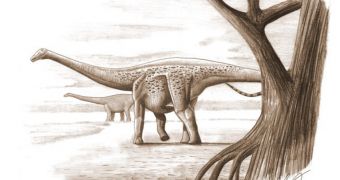Anthropologists and paleontologists were finally able to accurately confirm the existence of a diminutive species of dinosaurs on lands that are now part of Transylvania, in Romania. Fossilized remains belonging to the creatures have been discovered for the first time more than a century ago, but classifying the small sauropod species as a distinct one has not been performed until now. The dinosaur lived about 75 to 70 million years ago, and never grew more than the size of a horse, experts say.
For many decades, academics have been debating as to whether the discovered remains belonged to a separate species, or to a young dinosaur that was still in its earliest stages of growth. Some proposed that the dinosaur, called Magyarosaurus dacus, belonged to a class of giant sauropods called titanosaurs. The largest member of this group, called Argentinosaurus, could reach about ten times the mass of modern-day African elephants, and could literally shake the ground when it moved. Using modern techniques, experts were finally able to determine that the bones found in Transylvania actually belonged to a fully-grown adult. This in turn made them classify M. dacus as a distinct species.
The new investigations were conducted by German researchers based at the University of Bonn's Steinmann Institute Division of Paleontology. The team, led by expert Koen Stein, looked at the fossilized remains of 19 such dinosaurs, and collected 21 samples from this lot. The researchers then used a high-powered microscope to look at the microstructures inside the bones. They discovered that the remains belonged to individuals that had already grown to between 90 and 95 percent of their maximum size. “We were able to prove that by looking at the microstructure of the bone that they weren't juvenile,” Stein explains, quoted by LiveScience.
One of the possible explanations for the reduced size of these animals could be their environment. At the time when the creatures lived, Transylvania was not surrounded by mountains, as it is today, but was rather an island in the Tethys Ocean. This body of water suffered major transformations over millions of years, and eventually became the Mediterranean Sea. Experts propose that the lack of natural predators did not force M. dacus to grow to the impressive sizes of its relatives, which needed to be aware of many carnivorous predators. Additional details of the study can be found in the latest issue of the esteemed journal Proceedings of the National Academy of Sciences (PNAS).

 14 DAY TRIAL //
14 DAY TRIAL //